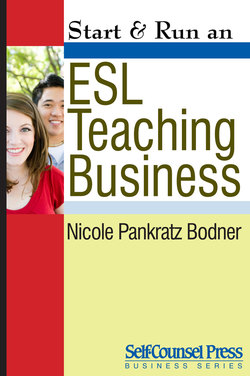Читать книгу Start & Run an ESL Teaching Business - T. Nicole Pankratz - Bodner - Страница 21
На сайте Литреса книга снята с продажи.
Teacher Training
ОглавлениеTeacher-training programs are not all created equal. Some are comprehensive university-based programs that last two years. Others run for a week and are designed to quickly prepare “teachers” for work overseas at English institutes. Still others are offered online, allowing prospective teachers to work at their own pace, even in remote places.
There are three main teacher-training courses:
• Teaching English as a Second Language (TESL)
• Teacher of English to Speakers of Other Languages (TESOL)
• Teaching English as a Foreign Language (TEFL)
For the most part, TESL, TESOL, and TEFL amount to the same thing. The difference is in the content they prepare you to teach. For example, TEFL focuses on teaching content designed for students living in their home country, rather than for students who are living and studying in an English-speaking country. Students studying English in their home country are less likely to need help with practical everyday conversation and more likely to need academic or workplace English for the purpose of test preparation.
Teacher training is becoming increasingly competitive. Already, many North American ESL schools have regulations regarding teacher qualifications, making it difficult for new teacher-training organizations to establish credibility. However, there is room for teacher training designed for specific types of people planning to travel and teach overseas.
In recent years, there has been a push from industry leaders to create ESL associations that adhere to guidelines and restrictions about teaching credentials. The consensus seems to be that the more time spent studying and practicing teaching, the better equipped the teacher. Of course, whether this is true is debatable and is not at issue here. (Indeed, on more than one occasion I have witnessed irreparable damage done in schools by teachers with amazing credentials and decades of experience.) What is important is that if you start an ESL-teacher-training business, your students could have difficulty getting their credential recognized if your program does not meet the current, and ever-changing, industry standards.
In some cases, credential recognition is not an issue. For example, you can offer teacher-training programs to international students planning to teach English when they return to their home country. Or your program could be designed for North Americans hoping to make some money while traveling in other countries.
